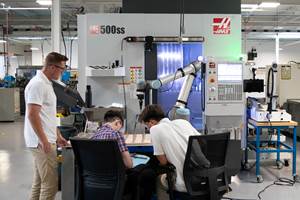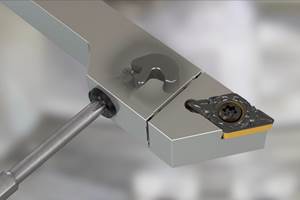Silicon Powder Additives Proven Safe And Effective In EDM
As with any new EDM innovation, the effectiveness of various powder finish processes will be debated. Likewise, dual-tank systems will be compared to single-tank systems. Here's a viable answer to that debate.
Share





Innovations in additive technology allow shops to produce fine finishes without the hassle of polishing. Standard EDM matte and highly reflective, glossy, mirror finishes are available from the same machine. But as with any new innovation, the effectiveness of various powder finish processes will be debated. Likewise, dual-tank systems will be compared to single-tank systems.
Mitsubishi EDM’s entry in the additive process marketplace is represented by its EPX Series of ram (sinker) EDM models. Currently, the series includes two models, the EPX22 and the EPX30. The dual tanks on these machines allow conventional machining on the standard oil side and silicon powder operation on the slurry side. Large, rough burn contaminants are isolated from the mix, increasing the life of the finishing fluid. The EPX22 accepts workpieces as large as 900 mm wide, 600 mm deep, and 300 mm tall; while the larger EPX30 accepts workpieces 1100, 700, and 350 mm respectively.
The system works with the silicon powder in suspension as larger spark energy is discharged from the electrode striking a powder particle within the gap and dispersing this energy to produce a very uniform finish. However, in order to fully understand the benefits of powder EDM, certain myths must be cleared up. Silicon is a non-toxic, natural element found commonly in nature. Refined into a metallic silicon material, it is used as a semi-conductor in computer microchips. Taking that material and grinding it to a fine powder creates the additive for the silicon powder finishing process. This silicon powder contains no chrome, which is a toxic, heavy metal, nor any other unsafe material. According to the company, every venue implicated by this process has been explored in order to be certain of its safety. The research of perfecting the use of silicon powder in this EDM finishing process has progressed for over a decade, the company says.
Developers point out that if a manufacturer uses a powder additive in a single-tank system, common paper filters cannot be used because they would filter out the powder additive. Magnetic separators are often employed instead, but that limits them to burning only magnetic materials. That means that today’s many alloyed materials, along with aluminum, titanium and carbide, could not be burned on such single-tank systems.
Mitsubishi EDM’s two-tank system is designed for more flexibility since the standard dielectric oil and the powder finishing material are in separate tanks. Once the part has been completed using standard oil (down to a 6 Rmax finish), the machine automatically switches over to the powder oil side for the final power setting that produces the highly reflective, glossy, mirror finish. Very little powder is consumed, the company says, because it is only used for the final setting during which only 0.0001 inch to 0.0002 inch of the workpiece material is removed.
There is no possibility that silicon powder will settle or clump in the work tank of EPX machines because a high-speed tank circulation system, along with the Fuzzy Pro 2 jump strategy and orbit cycles, eliminates powder separation from the oil. This process produces a very uniform finish to both sidewalls and the cavity bottom.
Machining with a powder additive reduces the need for tedious hand polishing. This can be accomplished with either type of powder process. However, the dual-tank system creates an even greater cost savings since standard, filtered oil is used for the majority of the machining process. According to developers, the total cost of this type of powder operation shows a 68 percent savings when compared to single-tank systems. Having a dual-tank system allows for a greater range of machining possibilities since not all jobs require the ultimate in EDM surface finishes. A dual-tank machine is available for non-magnetic jobs that may require an average, matte EDM finish that can be processed and completed without wasting the powder additive. It is pointed out that the second tank can be run like an air conditioner, to be switched on and off as the situation requires.
Computer technology has benefited all areas of EDM machining, and the dual-tank powder finishing system is no exception. Programming is as simple and easy as it is on non-additive systems. The Fuzzy Pro 2 Control emulates an experienced operator, automating the process. There is no re-programming or manual intervention involved during the machining process because the system is designed to automatically switch from one tank to the next.
Collectively, the innovations in the EDM industry are promising. When looked upon generally, it is clear that powder finishing can dramatically improve productivity in many mold shops by virtually eliminating hand polishing of mirror finishes.
Click here to learn more about supplier MC Machinery Systems, Inc..
Related Content
6 Machine Shop Essentials to Stay Competitive
If you want to streamline production and be competitive in the industry, you will need far more than a standard three-axis CNC mill or two-axis CNC lathe and a few measuring tools.
Read MoreOrthopedic Event Discusses Manufacturing Strategies
At the seminar, representatives from multiple companies discussed strategies for making orthopedic devices accurately and efficiently.
Read MoreCNC Machine Shop Honored for Automation, Machine Monitoring
From cobots to machine monitoring, this Top Shop honoree shows that machining technology is about more than the machine tool.
Read MoreQuick-Change Tool Heads Reduce Setup on Swiss-Type Turning Centers
This new quick-change tooling system enables shops to get more production from their Swiss turning centers through reduced tool setup time and matches the performance of a solid tool.
Read MoreRead Next
Machine Shop MBA
Making Chips and 91ÊÓƵÍøÕ¾ÎÛ are teaming up for a new podcast series called Machine Shop MBA—designed to help manufacturers measure their success against the industry’s best. Through the lens of the Top Shops benchmarking program, the series explores the KPIs that set high-performing shops apart, from machine utilization and first-pass yield to employee engagement and revenue per employee.
Read MoreLast Chance! 2025 Top Shops Benchmarking Survey Still Open Through April 30
Don’t miss out! 91ÊÓƵÍøÕ¾ÎÛ's Top Shops Benchmarking Survey is still open — but not for long. This is your last chance to a receive free, customized benchmarking report that includes actionable feedback across several shopfloor and business metrics.
Read MoreAMRs Are Moving Into Manufacturing: 4 Considerations for Implementation
AMRs can provide a flexible, easy-to-use automation platform so long as manufacturers choose a suitable task and prepare their facilities.
Read More





















